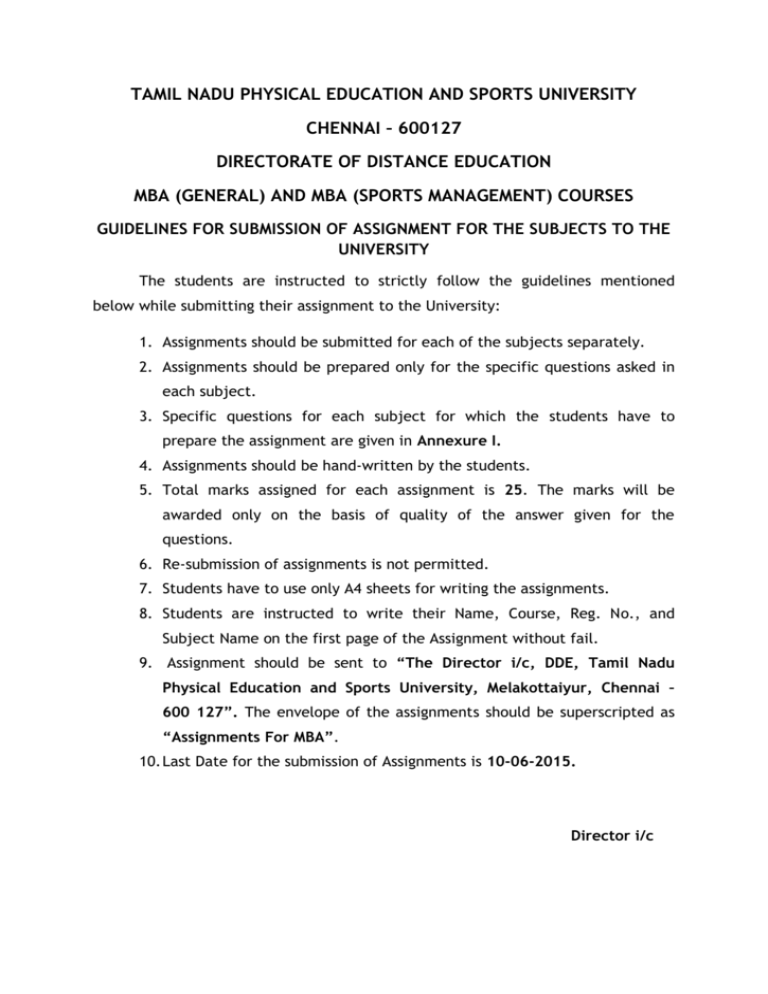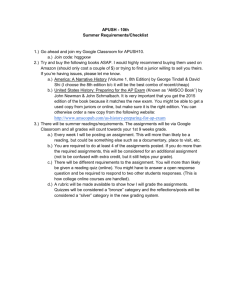(general) and mba (sports management)
advertisement

TAMIL NADU PHYSICAL EDUCATION AND SPORTS UNIVERSITY CHENNAI – 600127 DIRECTORATE OF DISTANCE EDUCATION MBA (GENERAL) AND MBA (SPORTS MANAGEMENT) COURSES GUIDELINES FOR SUBMISSION OF ASSIGNMENT FOR THE SUBJECTS TO THE UNIVERSITY The students are instructed to strictly follow the guidelines mentioned below while submitting their assignment to the University: 1. Assignments should be submitted for each of the subjects separately. 2. Assignments should be prepared only for the specific questions asked in each subject. 3. Specific questions for each subject for which the students have to prepare the assignment are given in Annexure I. 4. Assignments should be hand-written by the students. 5. Total marks assigned for each assignment is 25. The marks will be awarded only on the basis of quality of the answer given for the questions. 6. Re-submission of assignments is not permitted. 7. Students have to use only A4 sheets for writing the assignments. 8. Students are instructed to write their Name, Course, Reg. No., and Subject Name on the first page of the Assignment without fail. 9. Assignment should be sent to “The Director i/c, DDE, Tamil Nadu Physical Education and Sports University, Melakottaiyur, Chennai – 600 127”. The envelope of the assignments should be superscripted as “Assignments For MBA”. 10. Last Date for the submission of Assignments is 10-06-2015. Director i/c ANNUXURE I 1. PRINCIPLES OF MANAGEMENT 1. a) Explain the overall development in management thought b) Explain briefly the different factors affecting the organizational environment 2. a) Explain the relationship of planning and control b) Explain the process of MBO 3. Explain briefly about the various types of organizational structures 4. Explain the various types of leadership with its different styles 5. Discuss the impact of IT in Management concept. 2. MANAGERIAL ECONOMICS 1. Define the term managerial economics and its scope. What do you mean by a firm in an economy? What should be the objectives of a firm in an economy? 2. Explain the law of demand and law of supply. What are the reasons for respective shapes of demand and supply curves? What are the exceptions to the law of demand? 3. Explain about the short and long run cost output relationship and economics of scale. 4. What are the objectives of pricing policy? Also explain the method of price skimming and penetration pricing with examples. 5. Write the problems faced in national income calculation. 3. MANAGEMENT ACCOUNTING 1. Write a note on accounting concepts and standards illustrating its practical applications. 2. Prepare the final accounts from the given Trial Balance for the period 31st December, 2013. Particulars Debit Particulars Balances Credit Balances Opening Stock 9,500 Sales 1,84,000 Depreciation 5,000 Capital 1,65,300 Carriage inwards 1,700 Creditors Furniture 7,000 Bills Payable Plant & 17,500 5,000 2,00,000 Machinery Cash 8,600 Salaries 7,500 Debtors 17,000 Discount 1,500 Bills Receivable 16,000 Wages 15,000 Purchases 83,000 Total 3,71,800 Total 3,71,800 Adjustments: i. Closing Stock Rs 45,000. ii. Outstanding Salary Rs 2,500. iii. Charge 10% interest on Capital. 3. Discuss the different techniques of analysis and interpretation of financial statements. 4. A retail outlet sells a single product at Rs.100 per unit. Unit variable cost is Rs.70 and fixed cost amounts to Rs.24, 00,000 per annum. With this data you are required to calculate the following:- a. P/V Ratio b. Break-even sales in Rupees. c. Break-even sales in Units. You are also required to calculate the above once again assuming variable cost increases by Rs.6 per unit, without increase in selling price. 5. Explain the meaning, purpose and the method of preparing the Flexible Budget. 6. BUSINESS LAW 1. Discuss the essential elements of a valid contract and explain the remedies for breach of contract. 2. Discuss the authorities, rights and liability of partners. 3. Discus the different kinds and discharge of Negotiable Instruments. 4. Explain how to form a company and discuss the types of companies. 5. Discuss the contents of The Foreign Exchange management Act, 1999. 7. OPERATIONS MANAGEMENT 1. a) What is operations management. Why is operations management important in all types of organizations. b) What is Input – Transformation – Output process? 2. a) Explain the Product Selection and stages involved therein. b) What is producibility?. How does it affect product selection? 3. a) Define job design. How has management viewed job design since the industrial revolution? b) List the important factors that must be addressed in job design and briefly discuss the importance of each one. 4. What does top management expect from the operations functions?. Discuss in detail with illustrations. 5. What are the performance objectives of operations and what are the internal and external benefits which derive from excelling In each of them?. 6. MARKETING MANAGEMENT 1. Discuss the changing Scenario of Business and Marketing with suitable examples. 2. Explain the factors influencing consumer behavior and discuss the stages of consumer decision process. 3. Discuss the different bases of market segmentation with examples. 4. Explain how to develop a new product and explain the stages of Product Life Cycle. 5. Explain the significance of Brand Equity and Brand Positioning to the company with suitable examples. 7. FINANCIAL MANAGEMENT 1. Discuss the sources of long term funds and short term financing for the company. 2. Discuss the advantages and disadvantages of different methods of project appraisal. 3. Explain the significance of cost of capital and explain weighted average cost of capital and EBIT-EPS analysis. 4. Discuss the Gorden and Walter theory and MM theory of Dividend with suitable examples. 5. Explain the factors determining the working capital requirements of a firm and explain the inventory management techniques. 8. HUMAN RESOURCE MANAGEMENT 1. Explain the essence and nature of human resource management and contrast this with traditional personnel management. 2. Explain the role of HR professional in human resource planning process in organizations. 3. Explain why recruitment and selection is an important issue, particularly in relation to issues concerning commitment and attitude and workforce heterogeneity. 4. Suppose you are going to design a training programme for newly hired first-line sales managers results from the needs assessment indicate that they will need training on company policies and procedures, handling customer complaints, and motivating sales personnel. What learning principles will you build into the programme? What training methods would you choose? Explain your choices. 5. How can we design the pay structure for an appropriate Industry? Explain with example.




